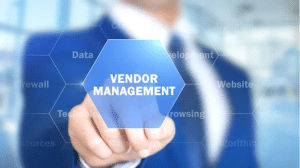In today’s fast-paced and ever-changing business environment, mastering efficient supply chain management has become the key to an organization’s competitiveness. Here, the Vendor Management System (VMS) plays a crucial role. More than just a tool, it is a core component of a company’s strategy, helping it to remain flexible and efficient in a challenging marketplace.
However, many may not be clear on what exactly a Vendor Management System is, how it works, and what specific impact it has on business operations? More importantly, what are the benefits and challenges that organizations encounter when implementing a VMS? This article will delve into these questions and reveal the importance and value of a Vendor Management System in a modern organization.

What is a Vendor Management System?
A vendor management system is a cloud-based software that manages all interactions between a business and its suppliers through a centralized approach. It is more than a simple system of record. It is a comprehensive platform for tracking and optimizing the entire process from supplier selection to contract execution to final payment. For example, a VMS can automate standard operating procedures such as supplier qualification, contract review and performance evaluation, thereby increasing efficiency and reducing the risk of human error.
Key components of a sales or management system
Data Analysis and Reporting
- Modern VMSs integrate advanced data analytics tools that can process and interpret large amounts of sourcing and supplier data.
- These tools not only help identify cost-saving opportunities, but also provide insights into market dynamics and supplier performance.
- Customized reporting capabilities allow companies to assess supply chain efficiency based on their specific needs and objectives.
Contract Management
- An automated contract management system tracks the lifecycle of a contract from creation, negotiation, execution to renewal.
- It provides a centralized platform to store all contract documents, ensuring easy access and auditing.
- In addition, this component monitors contract compliance to ensure that the business adheres to relevant laws and regulations.
Vendor Relationship Management
- VMS provides powerful communication tools and interfaces that enable organizations to maintain effective communication with suppliers.
- It also helps organizations assess and manage supplier performance to ensure supply chain stability and reliability.
- Through regular evaluation and feedback, enterprises can work together with suppliers to continuously improve product and service quality.
The integration of these functions not only improves the transparency of supply chain management, but also enhances the ability of enterprises to adapt to market dynamics. In the next sections, we will further explore the workflow of a Vendor Management System, as well as the benefits and challenges that may be encountered when implementing a VMS.
Vendor Management System Workflow
The Vendor Management System workflow is a comprehensive framework designed to improve efficiency and transparency. It covers all key stages from supplier onboarding to procurement, invoice processing and final payment.
1. Supplier onboarding
- Automated information collection: The VMS automates the collection of suppliers’ legal, financial and operational information such as tax identification numbers, quality certifications and credit reports.
- Ongoing data validation: Not only is validation performed during initial onboarding, VMS continuously monitors and updates supplier information to ensure it is always current and accurate.
- Risk Assessment: VMS is able to assess the risk and compliance of potential suppliers, helping organizations make informed partnering decisions.
2. Request for Proposal (RFP) and Solicitation
- Standardized process: VMS provides templates and tools that enable companies to quickly create and issue RFPs.
- Proposal Evaluation: Once responses are received, VMS can automatically evaluate proposals based on preset criteria, helping organizations quickly identify the most suitable candidates.
- Enhanced Collaboration and Communication: VMS allows multiple departments or team members to participate in the evaluation process, ensuring comprehensive and unbiased decision-making.
3. Purchase Order Management
- Automated order generation: From requirement identification to order generation, VMS can automate the entire process, reducing manual work.
- Transparent approval process: By setting specific approval levels and criteria, VMS ensures that the order approval process is clear and consistent.
- Real-time tracking and reporting: VMS allows real-time tracking of order status, providing instant feedback on delivery times and order accuracy.
4. Invoice processing and payment
- Automated Invoice Processing: VMS can automatically match invoices and purchase orders to quickly verify the accuracy of invoices.
- Accelerated Approval Process: With automated workflows, VMS can significantly accelerate the approval process and shorten payment cycles.
- Cash Flow Management: VMS provides data analytics tools to help companies optimize their payment strategies and improve overall cash flow.
Benefits of implementing a vendor management system
- Increase Efficiency
- Automate core processes: VMS significantly improves efficiency by automating key processes such as invoice processing, order management and contract renewal.
- Reduce redundant work: By centralizing supplier information, VMS reduces the need for repetitive data entry and processing.
- Accelerates decision-making: Quick access to key information and data analysis tools makes the decision-making process faster and more accurate.
- Cost savings
- Optimize Supplier Selection: VMS helps companies reduce procurement costs by selecting the most appropriate suppliers through performance evaluation and cost analysis.
- Contract optimization: Enterprises can manage contracts more effectively and avoid automatically renewing unfavorable contracts or missing out on more favorable renewal opportunities.
- Reduced faults and delays: By reducing manual errors and speeding up processes, VMS helps to reduce additional costs caused by errors or delays.
- Enhanced Compliance
- Ensure Regulatory Compliance: VMS tracks and monitors compliance requirements to ensure that organizations are adhering to industry and government regulations.
- Reduces audit risk: Centralized records and transparent processes make auditing easier and reduce the risk of non-compliance.
- Enhanced data security: VMS provides enhanced data security measures to protect sensitive information from breaches.
Challenges
- Technical integration
- Compatibility with existing systems: Ensuring that a VMS is compatible with an organization’s existing IT infrastructure and software platforms can take time and technical expertise.
- Data migration issues: Migrating data from legacy systems to a new VMS can be a complex and risky process.
- Employee training
- Skills Gap: Employees may need time to adapt to the new system, especially those unfamiliar with automation and cloud technologies.
- Ongoing education: As the VMS is updated and upgraded, employees need to be retrained on a regular basis to ensure that they are able to effectively utilize all of the system’s features.
- Change management
- Employee resistance: Resistance to a new system may come from uncertainty about the change or discomfort with the new technology.
- Management Challenge: Successful implementation of a VMS requires an effective communication strategy and change management skills to ensure buy-in from all stakeholders.
Conclusion
A Vendor Management System (VMS) is key for organizations to remain competitive in the modern business environment. While there may be some challenges to implementing a VMS, the long-term benefits – increased efficiency, reduced costs, and enhanced compliance – cannot be ignored. Choosing the right VMS and effectively managing the transition process will lead to continued business success and growth.

